Funny that it took me 20 years of cooking pasta to make spaghetti all’amatriciana, in which a small amount of cured meat – guanciale if you’re in central Italy, pancetta or bacon for the rest of us – adds deep sweet-saltiness to an easy onion and tomato sauce. Simple and flavorful, amatriciana has found an instant place in our regular rotation.
Before two of us became six of us, I didn’t stock much bacon in the house. Now I’ll make two pounds of bacon in the oven for a weekend breakfast without expecting any left over. But sometimes I’ll sneak out a few slices to save for dinner. It only takes a few slices to make a regular tomato sauce into something special.
Three classic Roman pasta sauces – amatriciana, carbonara and gricia – are all based on guanciale, an unsmoked pork jowl bacon. Pasta alla gricia, pasta tossed with cooked guanciale and pecorino romano cheese, is the predecessor to amatriciana. At some point in the late 18th or early 19th century, tomatoes were added, and the amatriciana – named for the town of Amatrice near Rome – was born.
Guanciale is hard to find outside of Italy, so for most of us pancetta (cured pork belly similar to bacon but not smoked) or bacon (usually cured and smoked) will have to do as a substitute. Over time onions and chile pepper have become common additions, and bucatini, thicker than spaghetti with a hole in the center, has become a favored pasta pairing. But according to Wikipedia, the dish is still served with spaghetti in Amatrice.
I love a good pantry meal. Canned tomatoes and onions are a given, and bacon is usually tucked away in my freezer. And I always have spaghetti.
Start with bacon in the pan.
Note to self – don’t walk away on frying bacon. Cook your bacon gently, and you won’t have my charred-pan problem. Remove excess fat, but leave enough for flavor.
Add onions and cook until soft.
The traditional recipe uses fewer tomatoes for a more spare sauce. But for Italians pasta is a first course which is followed by a meat/fish course. For Americans this is the meal, so this sauce is a bit more substantial.
Add chile flakes to taste.
Simmer sauce briefly while the pasta cooks, occasionally crushing tomatoes with a wooden spoon.
It’s a quick cook.
You can save the sauce for later too.
Save some pasta water before you drain the spaghetti. Splash in a bit when you toss the hot pasta with the sauce – the hot, starchy, salty liquid will help distribute the sauce nicely into the pasta. Pecorino romano cheese is the traditional topping if you have it, but in our already un-traditional version, good parmesan will do fine.
And in case you need it, a pronunciation guide:
- Amatriciana (uh-mot-tree-CHA-na)
- Guanciale (gwon-CHA-lay)
- Pancetta (pan-CHET-ta)
- Amatrice (uh-mot-TREE-chay)
Spaghetti all’Amatriciana
A small amount of pancetta/bacon adds big flavor to this tomato and onion sauce. An American verison of a classic dish from Amatrice, near Rome.
Ingredients
- 2 tablespoons olive oil (optional)
- 4 ounces (1/4 pound) pancetta or bacon, diced
- 1 medium onion, diced
- 1 28-ounce good-quality canned tomatoes (whole or diced)
- Crushed red pepper, to taste
- Grated pecorino romano or parmesan cheese
- 1 pound spaghetti
Directions
- Cook pancetta/bacon in a wide saucepan or skillet over medium heat (add a bit of olive oil if it’s sticking to the pan). Pour out all but a couple of tablespoons of the fat.
- Add diced onion and cook until soft and transparent.
- Add tomatoes, breaking up whole tomatoes with a spoon. Season with crushed red pepper to taste.
- Simmer on low for 10-15 minutes, until tomatoes are soft and break down into the sauce. Remove from heat.
- Cook spaghetti in a large pot of salted water (salty like the sea), using tongs or a spoon to separate the noodles. Cook until al dente – spaghetti should still have a chewy bite at the center. Reserve a cup of the cooking water and drain the rest.
- Toss spaghetti with sauce, adding a bit of the cooking water if necessary (this helps smooth distribution of sauce with the pasta). Serve hot with grated cheese.
Serves four.
Notes
- Traditionally this dish uses guanciale, an unsmoked pork jowl bacon.
- In Italy, this would be a first course, followed by a second course of meat or fish. So the Italian sauce, which would use fewer tomatoes drained of juice, is lighter and more spare. For American tastes, this is a heartier pasta, with more sauce. Use six ounces of pancetta or bacon for an even sturdier meal.
- This sauce keeps well in the refrigerator, so you can make it a day or two ahead of time.
Here’s the link to a printable version.

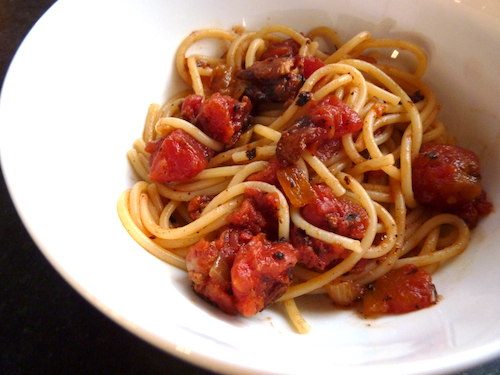
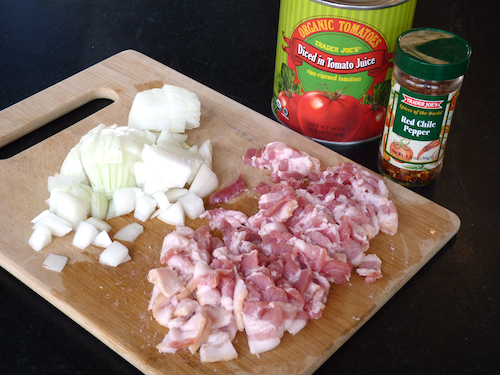
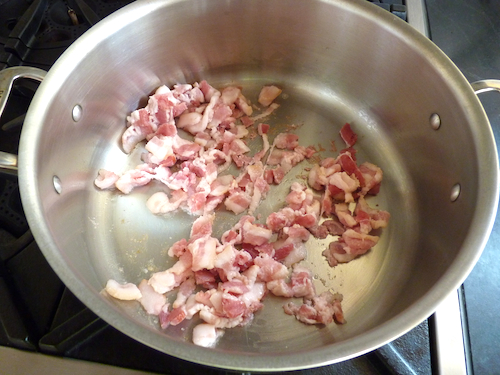
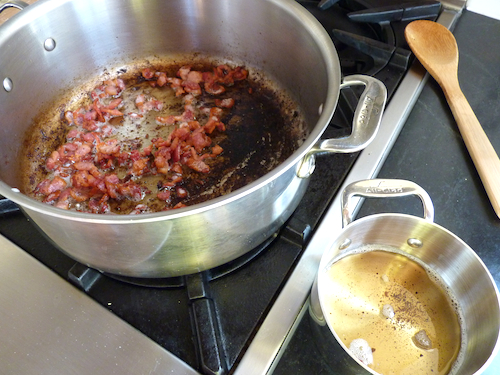
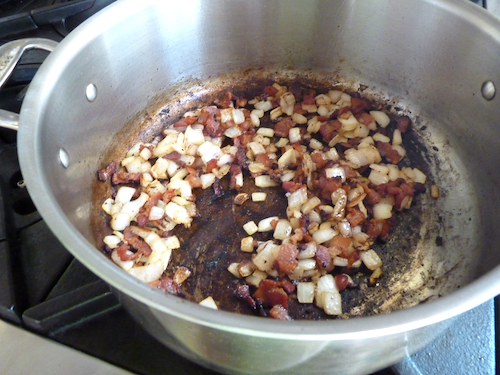
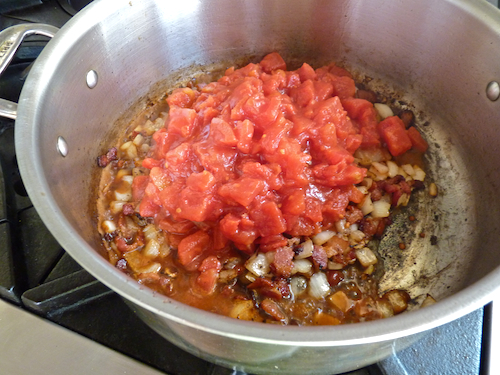
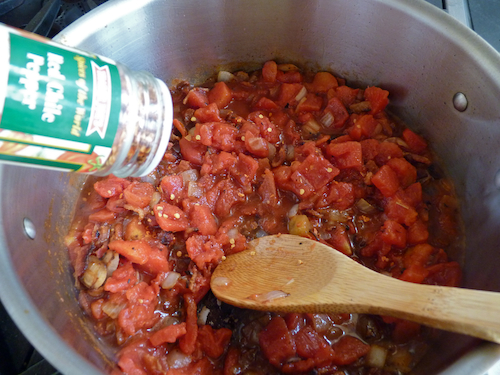
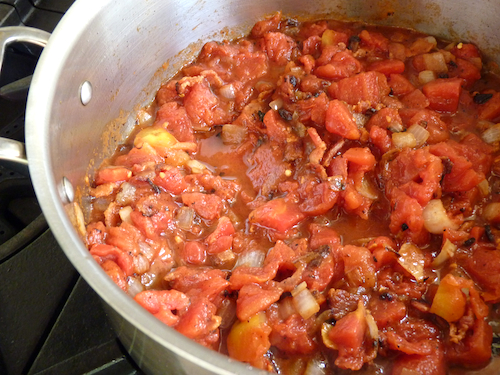
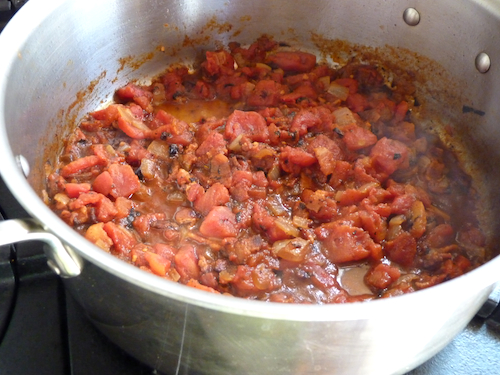
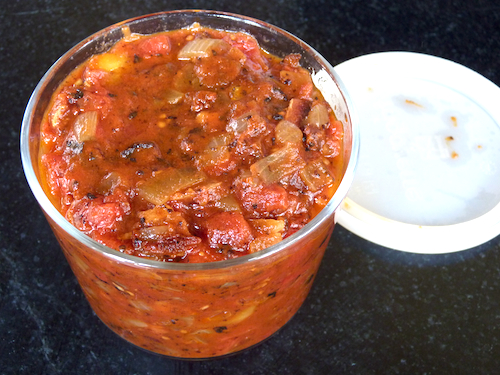





I make a version of this from the Two Dudes, One Pan cookbook. Their recipe also adds chicken. For some reason artichoke hearts just sounded like a good addition to me so I added some the first time I made the recipe and haven’t been able to make it without them since.
mmm…great idea! thanks for sharing.
I keep coming back to this recipe. It is so easy to make and such a comfort meal for me. I LOVE it, and I love even more that my entire family loves it.